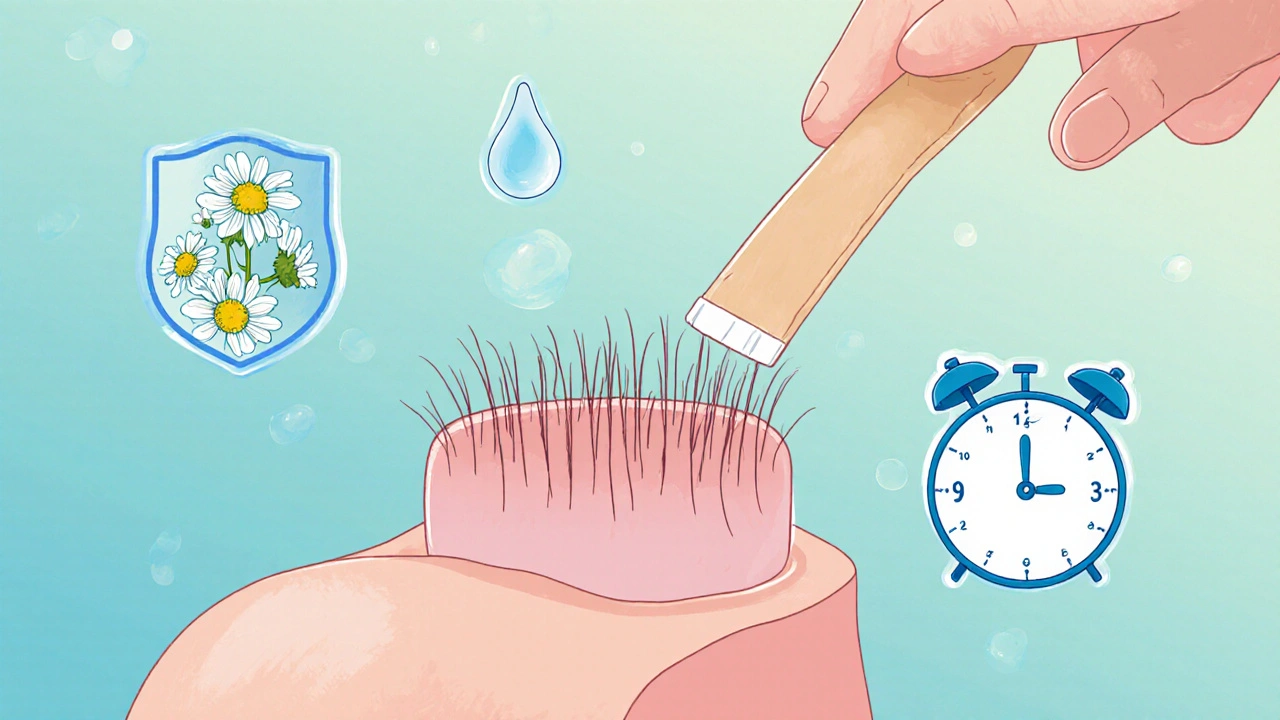Waxing hurts. Everyone knows that. But what if it didn’t have to hurt so much? You’ve probably sat through a session, gritting your teeth while the esthetician yanks a strip off your leg, only to spend the next two days flinching at the sight of your own skin. The truth? Pain isn’t inevitable. It’s often the result of outdated techniques, poor wax formulas, or skipping simple prep steps. The good news? You can make waxing significantly less painful-with the right wax, the right timing, and the right habits.
Why waxing hurts (and why it doesn’t have to)
Waxing pulls hair out from the root. That’s the whole point. But pain comes from how that hair is pulled, not just that it’s pulled. If the wax is too cold, it hardens too fast and grips unevenly. If it’s too hot, it burns the skin. If the strip is yanked sideways instead of parallel to the skin, you’re tearing tissue, not removing hair. And if your skin is dry, dehydrated, or already irritated, every tug feels like a knife.
Modern wax formulas are designed to change that. Soft waxes now include soothing ingredients like aloe vera, chamomile, and calendula. Hard waxes often contain titanium dioxide and beeswax blends that grip hair but not skin. Some premium formulas even add lidocaine derivatives in trace amounts-enough to numb the surface without masking real damage. You’re not just removing hair anymore. You’re doing it with a buffer.
Choosing the right wax formula for less pain
Not all waxes are created equal. The type you use makes a huge difference in how much it stings.
- Hard wax is your best bet for sensitive areas like the bikini line, underarms, or face. It hardens as it cools, clinging to hair but not skin. Brands like Cirepil, Sally Hansen Hard Wax Beans, and GiGi Hard Wax are formulated to minimize skin traction. They’re thicker, stickier, and melt at lower temperatures-meaning less heat on your skin.
- Soft wax requires cloth strips and is better for larger areas like legs or arms. Look for formulas labeled "sensitive skin" or "hypoallergenic." Avoid ones with synthetic resins or harsh fragrances. Some now include oat extract or green tea extract to calm redness.
- Roll-on waxes are newer and designed for home use. They apply cleanly without sticks, and many have cooling gels built into the applicator. They’re not as strong as salon-grade, but for fine hair, they’re surprisingly gentle.
Check the ingredient list. Avoid waxes with parabens, phthalates, or synthetic dyes. These don’t cause pain directly, but they irritate skin over time, making future sessions worse. Instead, look for natural oils-jojoba, coconut, or shea butter-as the first few ingredients. These lubricate the skin and reduce friction during removal.
Pre-wax prep: The secret step most people skip
Here’s what nobody tells you: pain starts hours before you even touch the wax. If your skin is dry, tight, or covered in dead cells, the wax will grab it. That’s not hair removal. That’s skin removal.
Three days before waxing, start exfoliating. Use a gentle scrub with sugar or finely ground apricot kernels. Don’t overdo it-once every other day is enough. This lifts dead skin so the wax can target hair follicles directly. On the day of waxing, avoid moisturizers, oils, or lotions. They create a barrier that makes the wax slip, forcing you to reapply and tug harder.
Also, skip caffeine and alcohol for at least 4 hours before. Both thin your blood and increase sensitivity. If you’re on your period, wait until after. Estrogen levels drop right before your period, making skin more reactive. A study from the Journal of Cosmetic Dermatology in 2023 found women reported 37% less pain when waxing mid-cycle versus right before menstruation.

Waxing technique: How to pull it right
Even the best wax fails with bad technique. The key is speed and direction.
When removing the strip, hold the skin taut with one hand. With the other, pull the strip back on itself-parallel to the skin, not upward. Think of it like peeling off a sticker, not ripping off a bandage. Pull fast. Slow pulls increase pain because the hair stretches before breaking. Fast removal snaps it cleanly.
Apply wax in the direction of hair growth. Remove against it. This ensures the follicle is fully gripped. Don’t re-wax the same spot. That’s a recipe for bruising and inflammation. If you miss a hair, wait 24 hours and tweeze it instead.
Temperature matters too. Wax should feel warm, not hot. Test it on your inner wrist. If it’s uncomfortable there, it’s too hot for your legs. Most modern wax warmers have preset temperatures. Stick to them. Don’t crank it up to "get it done faster."
Aftercare: Calming the storm
After waxing, your skin is like a fresh scrape. It’s not just sore-it’s vulnerable. You need to treat it like a wound.
- Apply a cool compress or ice pack wrapped in a towel for 5-10 minutes. This reduces swelling and numbs nerve endings.
- Use a fragrance-free, alcohol-free lotion with centella asiatica or calendula. These are proven to speed healing and reduce redness. Avoid anything with retinol, glycolic acid, or vitamin C for 48 hours-they’ll burn.
- Wear loose clothing. Tight jeans or leggings rub against freshly waxed skin and cause ingrown hairs.
- Don’t sweat for 24 hours. No gym, no sauna, no hot yoga. Sweat clogs pores and triggers bumps.
Some people swear by witch hazel or tea tree oil. But those are antiseptics, not soothers. They can dry out skin and make irritation worse. Stick to calming, hydrating ingredients. A 2024 clinical trial showed that using a post-wax gel with 2% bisabolol reduced redness by 68% within 6 hours.

When to skip waxing entirely
Waxing isn’t for everyone. If you have rosacea, eczema, psoriasis, or active acne, skip it. Waxing can flare up these conditions. Same if you’re on Accutane or topical retinoids-you’re at risk of skin lifting or scarring.
Also, if you’ve had a bad reaction to waxing before, don’t push through it. Try sugaring instead. It uses a natural paste made from sugar, lemon, and water. It’s gentler because it only sticks to hair, not live skin. Or consider laser hair removal. It’s pricier upfront, but over time, it cuts down on pain, time, and hair regrowth.
Final reality check: Pain isn’t the enemy-expectations are
Let’s be honest: waxing will never feel like a massage. But it doesn’t have to feel like torture either. The goal isn’t zero pain. It’s manageable discomfort. Most people who switch to the right wax and follow the prep steps report pain dropping from an 8/10 to a 3/10. That’s not magic. That’s science.
Start with a small area-your upper lip or a single eyebrow-to test a new wax. See how your skin reacts. Keep a journal: what wax you used, when you waxed, what you applied before and after. After three sessions, you’ll know exactly what works for your body.
Waxing is a ritual. It’s not just about smooth skin. It’s about respecting your body’s limits. The right wax, the right timing, and the right care turn a painful chore into something you can actually look forward to.
Does waxing hurt less over time?
Yes. Hair grows back finer and sparser after repeated waxing, so there’s less to pull. Skin also gets used to the process. Most people notice a big drop in pain after 3-4 sessions, especially if they use gentle wax and proper aftercare.
Can I use numbing cream before waxing?
It’s not recommended. Over-the-counter numbing creams like lidocaine spray or gel can numb the surface but don’t reach the follicle where the pain happens. Worse, they mask signs of irritation or burns. If you can’t feel the wax is too hot, you risk damaging your skin. Stick to cooling gels and cold compresses after.
What’s the best wax for sensitive skin?
Hard wax formulas with natural oils like jojoba, shea butter, or chamomile extract are best. Brands like Cirepil Soft Blue, GiGi Hairoil, and Sally Hansen Hard Wax Beans for Sensitive Skin are top choices. Avoid waxes with synthetic fragrances or alcohol.
How long should hair be before waxing?
Hair should be about 1/4 inch long-roughly the length of a grain of rice. If it’s too short, the wax won’t grip it. If it’s too long, it’ll snap instead of pulling cleanly, making it more painful. Wait 2-3 weeks after shaving for optimal length.
Can I wax at home safely?
Yes, if you use the right tools and follow safety steps. Use a hard wax designed for home use, test the temperature first, and never re-wax the same spot. Avoid waxing sunburned, irritated, or broken skin. If you’re new, start with your legs or arms before trying bikini or underarms.







Eric Etienne
November 19, 2025 AT 21:27Waxing still sucks no matter what fancy wax you use. I tried all that ‘sensitive skin’ crap and still ended up looking like a boiled lobster. Just shave and deal with the stubble.
Amanda Ablan
November 20, 2025 AT 11:22Actually, the prep advice here is gold. I used to hate waxing until I started exfoliating 3 days prior and skipped coffee before. Big difference. Now it’s just a quick sting, not a trauma. Try it before you write it off.
Sandy Pan
November 21, 2025 AT 17:38There’s something deeply poetic about choosing to remove hair from your body like a ritual. It’s not just about aesthetics-it’s about reclaiming control over your skin, your discomfort, your boundaries. Pain becomes a signal, not a failure. The right wax, the right timing-it’s a meditation in patience.
We treat our bodies like machines that need fixing, but they’re living ecosystems. Waxing shouldn’t be war. It should be a quiet negotiation between you and your follicles.
And yet… we still reach for the strip like it’s a battle cry. Maybe the real breakthrough isn’t the wax formula. It’s the mindset.
Janiss McCamish
November 23, 2025 AT 10:55Hard wax for bikini line, no debate. Soft wax is for people who hate their skin. And yes, hair needs to be 1/4 inch-no excuses. I’ve seen too many people wax too soon and then cry when it doesn’t work.
Yashwanth Gouravajjula
November 24, 2025 AT 01:42In India we use sugar paste. Natural. Gentle. No chemicals. Works better than wax for most skin types. Just sugar, lemon, water. Boil it, cool it, pull it. No burns. No irritation.
Dylan Rodriquez
November 24, 2025 AT 10:38Love that this post doesn’t pretend waxing is magic. It’s not a spa day-it’s a skill. And like any skill, it gets better with practice. The key is consistency. After three sessions, my pain dropped from ‘screaming’ to ‘mild annoyance.’ That’s not luck. That’s science + patience.
If you’re new, start small. Upper lip. One strip. See how your skin reacts. Then go bigger. Don’t rush into a full leg wax on day one. You’re not training for a marathon, you’re learning your body’s language.
And please-no numbing creams. They trick you into ignoring real damage. Let the sting be your guide. If it hurts too much, stop. Adjust. Try again later. Your skin will thank you.
Kevin Hagerty
November 24, 2025 AT 20:37Wow another ‘waxing is chill if you do it right’ post. Yeah sure. I’ve been waxing since I was 16 and my skin still looks like a crime scene. This is just corporate skincare propaganda. Buy the $40 wax, feel better about your suffering. Classic.
Meredith Howard
November 24, 2025 AT 22:42Interesting data point about estrogen levels and pain sensitivity mid cycle. I wonder if the study controlled for psychological expectation bias. Also the 68 percent reduction with bisabolol-was that double blind? The methodology feels underreported
Kendall Storey
November 26, 2025 AT 08:08Bro the cooling gel after is non-negotiable. I use the one with centella asiatica-works like a charm. And yes, no sweat for 24 hours. I literally rescheduled my gym session. Worth it. My skin hasn’t broken out since I started this routine.
Richard H
November 27, 2025 AT 00:01Why are we even talking about this? In America we don’t need to wax. We got lasers. We got electrolysis. We got tech. Waxing is old school. If you’re still pulling hair out with sticky stuff, you’re behind the times.
Ashton Strong
November 28, 2025 AT 06:08Thank you for writing this with such care and precision. Many overlook the emotional weight of body hair removal, but this piece honors both the science and the sensitivity. The emphasis on aftercare-especially avoiding retinols and acids-is crucial. I’ve seen too many clients ruin their skin by rushing into actives too soon. Your guidance is both compassionate and clinically sound.
Steven Hanton
November 28, 2025 AT 23:34Just wanted to add one thing-don’t underestimate the power of breathing. When the strip goes on, take a slow inhale through your nose, hold for two seconds, then exhale slowly through your mouth as you pull. It calms your nervous system. I’ve coached clients through this and the difference is noticeable. Pain doesn’t disappear, but your reaction to it does.